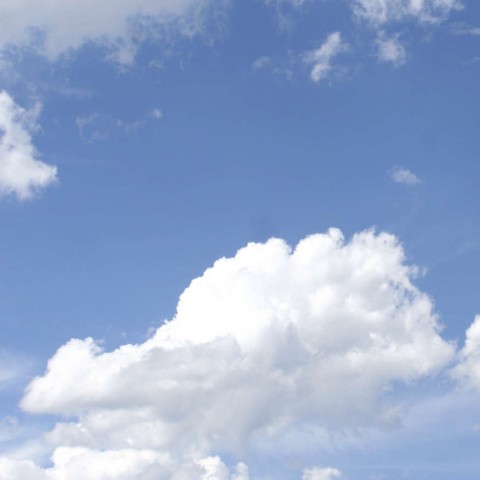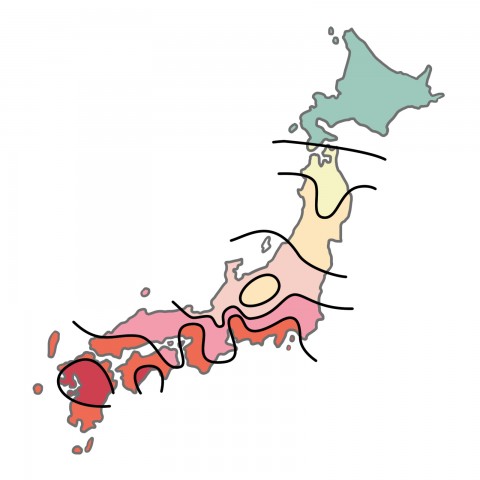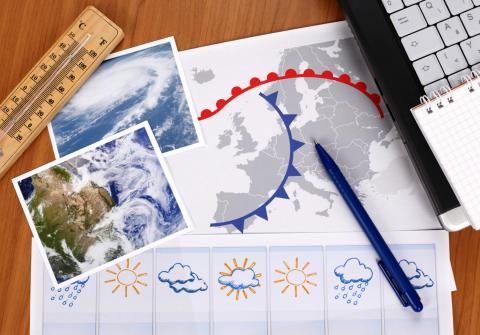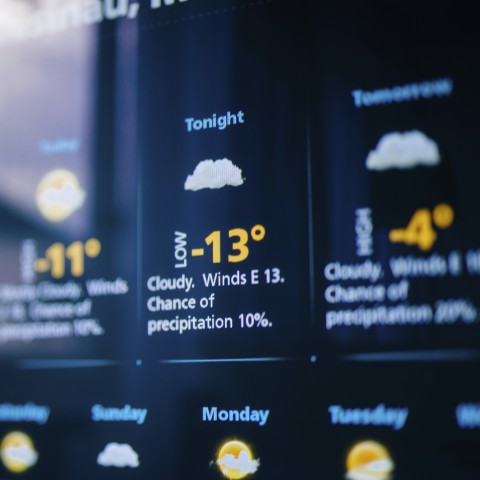Japan has four beautiful seasons, and every season has its own unique characteristics and weather. Whether you want to know the weather in Japan in April to visit the pretty 桜 (Sakura) or “cherry blossoms,” or research the weather in Kyoto, Japan for world heritage sightseeing, there are some useful words and phrases to know regarding weather in Japan!
Weather is one of the most useful topics for conversation and is also an essential topic in everyday life. When you know how to talk about the weather in Japanese, it will expand both your communication skills and vocabulary skills in Japanese, as there’s a variety of expressions relating to Japanese weather.
Let’s get started! By the time we get done, you’ll be talking about weather in Japanese like it’s nothing!

Table of Contents
- Japanese Weather Vocabulary: The Basics
- Japanese Weather Words – Temperature and Seasons
- The Most Common Sentence Patterns to Talk about the Weather
- Phrases and Patterns Used in the Japan Weather Forecast
- The Most Common Ways to Comment on the Weather in Japanese
- Conclusion: How JapanesePod101 Can Help You Learn More Japanese
1. Japanese Weather Vocabulary: The Basics
Ready to learn Japanese weather vocabulary? The Japanese have a rich array of words and phrases to describe a variety of weather conditions, so let’s take a look.
1- General Terms for Weather Conditions in Japanese
| Reading | Kanji | Hiragana | English | |
|---|---|---|---|---|
| 1 | Tenki | 天気 | てんき | weather |
| 2 | Tenkō | 天候 | てんこう | climate |
| 3 | Kishō jōkyō | 気象状況 | きしょうじょうきょう | weather condition |
| 4 | Soramoyō | 空模様 | そらもよう | the look of the sky |
There’s a wide range of variation to express weather conditions in Japanese.
2- Weather Adjectives in Japanese & More Weather Phrases
As you can see in the vocabulary chart below, there’s many ways to express “rain” in Japanese compared to other weather conditions. This is because Japan has a rainy season, and it also rains often throughout the year with different characteristics according to the season and weather conditions.
In addition, the sky is considered supernal and unreachable by humans according to Japanese tradition, and the weather is also thought to be controlled by supreme beings. For example, “lightning” in Japanese is Kaminari, and by adding the respectful honorific sama, we call the god of lightning Kaminari sama. Ancient people believed that when thunder roared in the sky, it meant the god of lightning was angry.
With this context in mind, here are a few more common ways of how to describe the weather in Japanese!
| Reading | Kanji | Hiragana | English | |
|---|---|---|---|---|
| 1 | Hare | 晴れ | はれ | sunny, clear weather |
| 2 | Kaisei | 快晴 | かいせい | clear weather without clouds |
| 3 | Kumori | 曇り | くもり | cloudy |
| 4 | Kumo | 雲 | くも | cloud |
| 5 | Ame | 雨 | あめ | rain |
| 6 | Kosame | 小雨 | こさめ | light rain / drizzle |
| 7 | Kirisame | 霧雨 | きりさめ | misty rain / light drizzle |
| 8 | Ōame | 大雨 | おおあめ | heavy rain |
| 9 | Tōriame | 通り雨 | とおりあめ | passing shower |
| 10 | Harusame | 春雨 | はるさめ | spring rain |
| 11 | Tenkiame | 天気雨 | てんきあめ | temporary rainfall in the sunshine |
| 12 | Gōu | 豪雨 | ごうう | downpour |
| 13 | Bōfūu | 暴風雨 | ぼうふうう | rainstorm |
| 14 | Raiu | 雷雨 | らいう | thunder-rainstorm |
| 15 | Yuki | 雪 | ゆき | snow |
| 16 | Ōyuki | 大雪 | おおゆき | heavy snow |
| 17 | Fubuki | 吹雪 | ふぶき | snowstorm / blizzard |
| 18 | Arare | 霰 | あられ | hailstone / falling iceball |
| 19 | Mizore | 霙 | みぞれ | sleet / snow with rain |
| 20 | Hyō | 雹 | ひょう | hail |
| 21 | Kaze | 風 | かぜ | wind |
| 22 | Soyokaze | そよ風 | そよかぜ | breeze |
| 23 | Kyōfū | 強風 | きょうふう | strong wind |
| 24 | Bōfū | 暴風 | ぼうふう | windstorm |
| 25 | Taifū | 台風 | たいふう | typhoon |
| 26 | Kisetsufū | 季節風 | きせつふう | monsoon / seasonal wind |
| 27 | Kaminari | 雷 | かみなり | thunder / lightning |
| 28 | Kiri | 霧 | きり | fog / mist |
| 29 | Nōmu | 濃霧 | のうむ | heavy fog / dense mist |
Please visit our vocabulary list about Weather and Learn the Top 15 Weather Conditions to listen to the actual Japanese pronunciation of these words.
2. Japanese Weather Words – Temperature and Seasons
It’s also useful to know the vocabulary used to express temperatures and seasons, which are often used in daily conversations and weather news. Below are common words and phrases for discussing the weather in Japanese!
1- Basic Terms
| Reading | Kanji | Hiragana | English | |
|---|---|---|---|---|
| 1 | Kion | 気温 | きおん | temperature |
| 2 | Shitsudo | 湿度 | しつど | level of humidity |
| 3 | Kiatsu | 気圧 | きあつ | atmospheric pressure |
| 4 | Kisetsu | 季節 | きせつ | season |
| 5 | Shiki | 四季 | しき | four seasons |
| 6 | Haru | 春 | はる | spring |
| 7 | Natsu | 夏 | なつ | summer |
| 8 | Aki | 秋 | あき | autumn |
| 9 | Fuyu | 冬 | ふゆ | winter |
| 10 | Uki | 雨季 | うき | rainy season |
| 11 | Tsuyu / Baiu | 梅雨 | つゆ / ばいう | rainy season (especially in Japan) |
| 12 | Kanki | 乾季 | かんき | dry season |
Please also check out Tsuyu: The Rainy Season in Japan on our website for Japanese audio.
2- Seasons in Japan – General Information
春 (Haru) : Spring
Spring in Japan is from March to May. Spring is one of the most beautiful seasons to visit Japan.
When it comes to Japanese weather in spring, temperatures gradually increase to a moderate and comfortable level. Although it’s spring, March has mostly cold days, while May has many sunny days with a clear sky and warm—or sometimes hot—temperatures. April is the most amazing month as cherry blossoms bloom fully, bringing beautiful notice of spring throughout Japan. Weather in Japan in April is literally the symbol of Japanese spring.
In addition, spring is a season full of new meetings, events, and liveliness, because April is the beginning month of both the school year and the business year in Japan. As the temperature becomes warmer, people become more active and it’s considered a good season to start something new.
夏 (Natsu) : Summer
Summer in Japan is from June to August. It starts with the rainy season, called 梅雨 (Tsuyu) which is usually in June and July. During the rainy season, most days are heavily rainy and the amount of precipitation is at its highest point of the year.
The full-blown summer starts after the rain, and once temperatures go up as high as above 40 degrees Celsius (104 degrees Fahrenheit). Japanese weather in summer, particularly in the months of July and August, can be quite uncomfortable due to hot temperatures and the high level of humidity. You can be standing in the shade, and still be sweating so much that you feel gross and sticky.
Summer heat makes people more energetic, making summer a season for many activities, and matsuri or Japanese festivals. Going to beaches, BBQing outside, fireworks, beer gardens, camping, and more, are popular summer activities in Japan.
秋 (Aki) : Autumn
Autumn, from September to November, is another beautiful season in Japan. Cooled down from the uncomfortable summer temperature, Japanese weather in autumn is pleasant. We have a word called 秋晴れ (akibare) which means “clear autumnal weather,” and most autumn days are delightfully sunny.
About 73% of the land in Japan is mountainous, and Japanese people appreciate the spectacular views of mountains which change colors in gradation of yellow, orange, and red. Visiting Kyoto in autumn will amaze you with views of traditional and historical buildings, surrounded by colorful nature. It’s just breathtaking.
Additionally, autumn is also the season of harvest and there’s a variety of tasty foods to indulge in during this time of year.
冬 (Fuyu) : Winter
Winter, from December to February, is a season of fun in Japan, especially if you like winter sports such as skiing, snowboarding, and skating. As for the Japanese weather in winter, the temperature in some of the northern and mountain regions go down below zero and it can get really cold. Mountains get a lot of snowfall.
Also, the Japanese onsen (hot springs) are essential in winter. They make you warm and relaxed after enjoying winter sports outside in the cold weather.
As an example of the weather in Tokyo, it’s quite rare to have snow in December. But when you research Japan weather in December, you’ll notice that northern regions already have snowy weather in December. Even though winter temperatures in Japan can get very cold, there are also many days of sunny weather in Tokyo.
3- Seasons in Japan – Information by Region
The land of Japan is stretching from the south to the north and the weather and climate vary according to regions.
The types of weather in Japanese regions varies based on factors such as latitude, with northern areas being colder and southern ones warmer. Learn more about this in the following sections.
Hokkaido / Tohoku
Hokkaido, the rhombus-shaped island in the northernmost part of Japan, and the Tohoku region are known for being cold and snowy, especially in winter. Temperatures go as low as -20, or even -30, degrees Celsius in some areas of Hokkaido. Further, due to the heavy snowfall, Hokkaido is one of the most popular destinations for skiing and snowboarding.
In summer, on the other hand, the climate is comfortable and nice as it doesn’t get as hot as it does in other parts of Japan. It’s also a popular place for summer vacations in order to avoid unbearable heat.
Kanto / Chubu / Kansai
The Kanto, Chubu, and Kansai regions are located in the main island of Japan, and Tokyo is within the Kanto region. Although the characteristics of the climate in each region vary in detail depending on its latitude and geography, these regions have typical Japanese weather in general.
Spring and autumn have comfortable and moderate weather conditions, summer is very hot and humid, and winter has some snowy days (though there are also sunny days, even with cold temperatures).
Kyushu / Okinawa
Kyushu is the most southwest of the four main islands, and Okinawa is the southernmost prefecture of Japan, which is 300km (about 186 miles) further southbound from Kyūshū. These regions are located in the southern part of Japan, and so it doesn’t get severely cold in winter. Due to its geography, summertime is longer and wintertime is shorter than in other regions of Japan.
Okinawa, the southern island surrounded by coral reefs, is the best summer resort destination for beautiful beaches and marine sports, such as scuba diving. Okinawa has a tropical climate and it’s beautiful in the summertime. However, keep in mind that it’s also often struck by typhoons near the end of summer. (There can be some extreme weather in Japanese regions near here!)
3. The Most Common Sentence Patterns to Talk about the Weather
Here are some common terms and sentences to talk about Japanese weather and climate, to enhance your conversation skills. Studying these lists will make you a master of describing the weather in Japanese!
1- Basic Terms for Describing Weather in Japanese
| Reading | Kanji | Hiragana | English | |
|---|---|---|---|---|
| 1 | Atsui | 暑い | あつい | hot |
| 2 | Atatakai | 暖かい | あたたかい | warm |
| 3 | Samui | 寒い | さむい | cold |
| 4 | Suzushii | 涼しい | すずしい | cool / chilly |
| 5 | Jimejime shita | – | じめじめした | humid |
| 6 | Mushiatsui | 蒸し暑い | むしあつい | humid and hot |
| 7 | Kansō shita | 乾燥した | かんそうした | dry |
The weather forecast is an essential part of everyday news.
2- Common Sentences to Talk about the Weather and Climate
Here, you’ll find some practical information on asking about weather in Japanese, and how to talk about weather in Japanese!
Questions for asking about the weather in Japanese:
- 今日の天気はどうですか。
Kyō no tenki wa dō desu ka.
How’s the weather today? - 気温は何度ですか。
Kion wa nan-do desu ka.
What is the temperature? - 外はどうですか。
Soto wa dō desu ka.
What’s it like outside? - 今日は寒いですか。
Kyō wa samui desu ka.
Is today cold?
Answers for talking about the weather in Japanese
You can state not only the weather condition, but also how it feels.
- 曇りです。
Kumori desu.
It’s cloudy. - 良い天気です。
Ii tenki desu.
It’s nice weather. - 晴れですが風が強いです。
Hare desu ga kaze ga tsuyoi desu.
It’s sunny, but there’s a strong wind. - 大雨でじめじめしています。
Ōame de jimejime shite imasu.
It’s raining heavily and humid. - 今日は晴れで暑いです。
Kyō wa hare de atsui desu.
Today is sunny and it’s hot. - 外は雪が降っていて寒いです。
Soto wa yuki ga futte ite samui desu.
It’s snowing outside and it’s cold. - 今の気温は20度です。
Ima no kion wa ni-jū-do desu.
The temperature is 20 degrees now. - 気温は1度でとても寒いです。
Kion wa ichi-do de totemo samui desu.
The temperature is very cold at one degree.
4. Phrases and Patterns Used in the Japan Weather Forecast
There are particular phrases and expressions which are often used in the weather forecast and news. Here are useful weather expressions in Japanese to help you out!
1- Vocabulary
| Reading | Kanji | Hiragana | English | |
|---|---|---|---|---|
| 1 | Tenki yohō | 天気予報 | てんきよほう | weather forecast |
| 2 | Saitei kion | 最低気温 | さいていきおん | minimum temperature |
| 3 | Saikō kion | 最高気温 | さいこうきおん | maximum temperature |
| 4 | Kiatsu | 気圧 | きあつ | atmospheric pressure |
| 5 | Teikiatsu | 低気圧 | ていきあつ | low atmospheric pressure |
| 6 | Kōkiatsu | 高気圧 | こうきあつ | high atmospheric pressure |
| 7 | Zensen | 前線 | ぜんせん | weather front |
| 8 | Baiu zensen | 梅雨前線 | ばいうぜんせん | seasonal rain front |
| 9 | Tsuyu iri | 梅雨入り | つゆいり | start of rainy season |
| 10 | Harō | 波浪 | はろう | ocean waves |
| 11 | Kōzui | 洪水 | こうずい | flood |
| 12 | Tsunami | 津波 | つなみ | tsunami / tidal wave |
| 13 | Taifū | 台風 | たいふう | typhoon |
| 14 | Chūihō | 注意報 | ちゅういほう | advisory |
| 15 | Keihō | 警報 | けいほう | warning |
| 16 | Hijō keihō | 非常警報 | ひじょうけいほう | emergency warning |
| 17 | Hinan kankoku | 避難勧告 | ひなんかんこく | evacuation advisory |
Also check out our Typhoon Season vocabulary list so you can listen to relevant Japanese audio.
1. Terms to Express Weather Change Trends and Time Segments
| Reading | Kanji | Hiragana | English | |
|---|---|---|---|---|
| 1 | Ichiji | 一時 | いちじ | at one point (in time) |
| 2 | Tokidoki | 時々 | ときどき | occasionally |
| 3 | Nochi | 後 | のち | subsequently / after |
| 4 | Shidai ni | 次第に | しだいに | gradually |
Japan uses Celsius for the measurement of temperature.
2- Phrases and Patterns Used in the Japanese Weather Forecast
- 今週から梅雨入りとなります。
Konshū kara tsuyu iri to narimasu.
The rainy season starts this week. - 今日の最低気温は7度で、最高気温は15度です。
Kyō no saitei kion wa nana-do de, saikō kion wa jū-go-do desu.
Today’s minimum temperature is 7 degrees and the maximum temperature is 15 degrees. - 東京の天気予報は晴れのち曇りです。
Tokyō no tenki yohō wa hare nochi kumori desu.
The weather forecast of Tokyo is sunny and subsequently cloudy. - 明日は曇り時々雨が降る見込みです。
Ashita wa kumori tokidoki ame ga furu mikomi desu.
It is likely to be cloudy with occasional rain tomorrow. - 午後から雨が降り、一時雪になる予測です。
Gogo kara ame ga furi, ichiji yuki ni naru yosoku desu.
It is going to rain from the afternoon, and it is estimated to snow at one point. - 台風6号が近づいています。波浪警報に注意してください。
Taifū roku-gō ga chikazuite imasu. Harō keihō ni chūi shite kudasai.
Typhoon No. 6 is approaching, please be aware of high wave warning.
5. The Most Common Ways to Comment on the Weather in Japanese
Weather talk is the best conversation starter. Here are some common ways to talk and comment about the weather according to season.
1- Spring
- 暖かくなってきましたね。もうすぐ桜が咲きそうです。
Atatakaku natte kimashita ne. Mō sugu sakura ga sakisō desu.
It’s becoming warmer. Cherry blossoms seem to bloom soon. - 気温が上ってきたので、ピクニックに最適な季節ですね。
Kion ga agatte kita node, pikunikku ni saiteki na kisetsu desu ne.
The temperature is getting warmer and it’s the best season for a picnic, isn’t it?
2- Summer
- 気温が高く日差しが強いので、熱中症に気をつけてください。
Kion ga takaku hizashi ga tsuyoi node, necchūshō ni ki o tsukete kudasai.
The temperature is high and the sunlight is strong, so please be careful of heat stroke. - すごく蒸し暑いですね。冷たいビールが飲みたいです。
Sugoku mushiatsui desu ne. Tsumetai bīru ga nomitai desu.
It’s very humid and hot; I want to drink cold beer.
3- Autumn
- 暑さが落ち着いて涼しくなりましたね。
Atsusa ga ochitsuite suzushiku narimashita ne.
The heat has let up and it’s become cool, hasn’t it? - 秋晴れで紅葉がとてもきれいです。
Akibare de kōyō ga totemo kirei desu.
The leaves changing color is very beautiful with the fine autumn weather.
4- Winter
- 外は寒いので暖かくしてください。
Soto wa samui node atatakaku shite kudasai.
It’s cold outside, please stay warm. - 最近はとても寒く風邪が流行っているので、気をつけてください。
Saikin wa totemo samuku kaze ga hayatte iru node, ki o tsukete kudasai.
It’s very cold these days and a cold is going around, so please take care.
6. Conclusion: How JapanesePod101 Can Help You Learn More Japanese
I hope this article about Japanese weather is helpful and makes your communication with Japanese people more enjoyable! Do you feel prepared to start talking about Japanese weather? Let us know!
If you would like to learn more about the Japanese language, you’ll find more useful content on JapanesePod101.com. We provide a variety of free lessons for you to improve your Japanese language skills. For example, Top 15 Questions You Should Know for Conversations to practice your Japanese with audio.
If you’re traveling to Japan, the following lessons are also helpful: 8 Tips for a Solo Japan Trip, How to Say Hello in Japanese: Practical Japanese Greetings, and The 5 Best Cities to Visit in Japan & Things to Do.
Know that your hard work will pay off. With enough practice, you’ll be speaking like a native in no time!






















